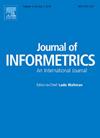瑞典博士生研究生产力的性别差异:分位数回归方法
IF 3.5
2区 管理学
Q2 COMPUTER SCIENCE, INTERDISCIPLINARY APPLICATIONS
引用次数: 0
摘要
本研究考察了性别生产力差距的博士生在瑞典使用比较设计。它特别关注在生产力分布的高端,男性的出版量一直比女性多,这种差距是如何扩大的。该研究基于2010年至2019年毕业于自然科学、工程技术、医学健康科学和社会科学等研究领域的10804名博士生的大型数据集。通过多分位数回归分析,我们能够对整个生产力分布中的性别生产力差距进行细致入微的分析。结果表明,在所有研究领域中,性别之间的生产率差距是一致的,而且这种差距向分布的高端方向扩大,即,在表现最好的领域中,生产率的性别差异也在扩大。然而,研究区域的比较显示出一定的异质性。在工程和技术领域,不断扩大的性别差距在分布的中间趋于平稳,但在极端尾部出现飞跃。在社会科学中,差距在分布的极端末端之前达到顶峰,然后开始下降。自然科学、医学和保健科学的差距逐渐向高端扩大。考虑到瑞典的背景-广泛采用博士教育的集体模式和论文出版格式-我们的主要结论是:(1)在所有研究的研究领域存在一致的性别生产力差距;(2)在生产力分布的上端,性别差距越来越大,通常出现在后期职业阶段,已经可以在博士研究期间观察到。本文章由计算机程序翻译,如有差异,请以英文原文为准。
Sex differences in research productivity among doctoral students in Sweden: A quantile regression approach
This study examines the sex productivity gap among doctoral students in Sweden using a comparative design. It focuses particularly on how the gap increases at the higher end of the productivity distribution, with men consistently publishing more than women. The study is based on a large dataset of 10,804 doctoral students who graduated between 2010 and 2019 in the research areas of the natural sciences, engineering and technology, medical and health sciences, and the social sciences. By applying multiple quantile regression analysis, we were able to conduct a nuanced analysis of the sex productivity gap across the whole productivity distribution. Results indicate a consistent productivity gap by sex across all research areas and that the gap increases towards the higher end of the distribution, i.e., the sex differences in productivity increase among the top performers. However, the comparison of research areas revealed some heterogeneity. In engineering and technology, the increasing sex gap levels off in the middle of the distribution but takes a leap at the extreme tail. In the social sciences, the gap peaks just before the extreme end of the distribution and then starts decreasing. The natural sciences and medical and health sciences show a more gradual increase in the gap towards the higher end. Taking into account the Swedish context – with its widespread adoption of the collective model of doctoral education and the thesis-by-publication format – our main conclusions are: (1) there exists a consistent sex productivity gap across all studied research areas, and (2) the increasing sex gap at the upper end of the productivity distribution, commonly seen in later career stages, can already be observed during doctoral studies.
求助全文
通过发布文献求助,成功后即可免费获取论文全文。
去求助
来源期刊

Journal of Informetrics
Social Sciences-Library and Information Sciences
CiteScore
6.40
自引率
16.20%
发文量
95
期刊介绍:
Journal of Informetrics (JOI) publishes rigorous high-quality research on quantitative aspects of information science. The main focus of the journal is on topics in bibliometrics, scientometrics, webometrics, patentometrics, altmetrics and research evaluation. Contributions studying informetric problems using methods from other quantitative fields, such as mathematics, statistics, computer science, economics and econometrics, and network science, are especially encouraged. JOI publishes both theoretical and empirical work. In general, case studies, for instance a bibliometric analysis focusing on a specific research field or a specific country, are not considered suitable for publication in JOI, unless they contain innovative methodological elements.
 求助内容:
求助内容: 应助结果提醒方式:
应助结果提醒方式:


